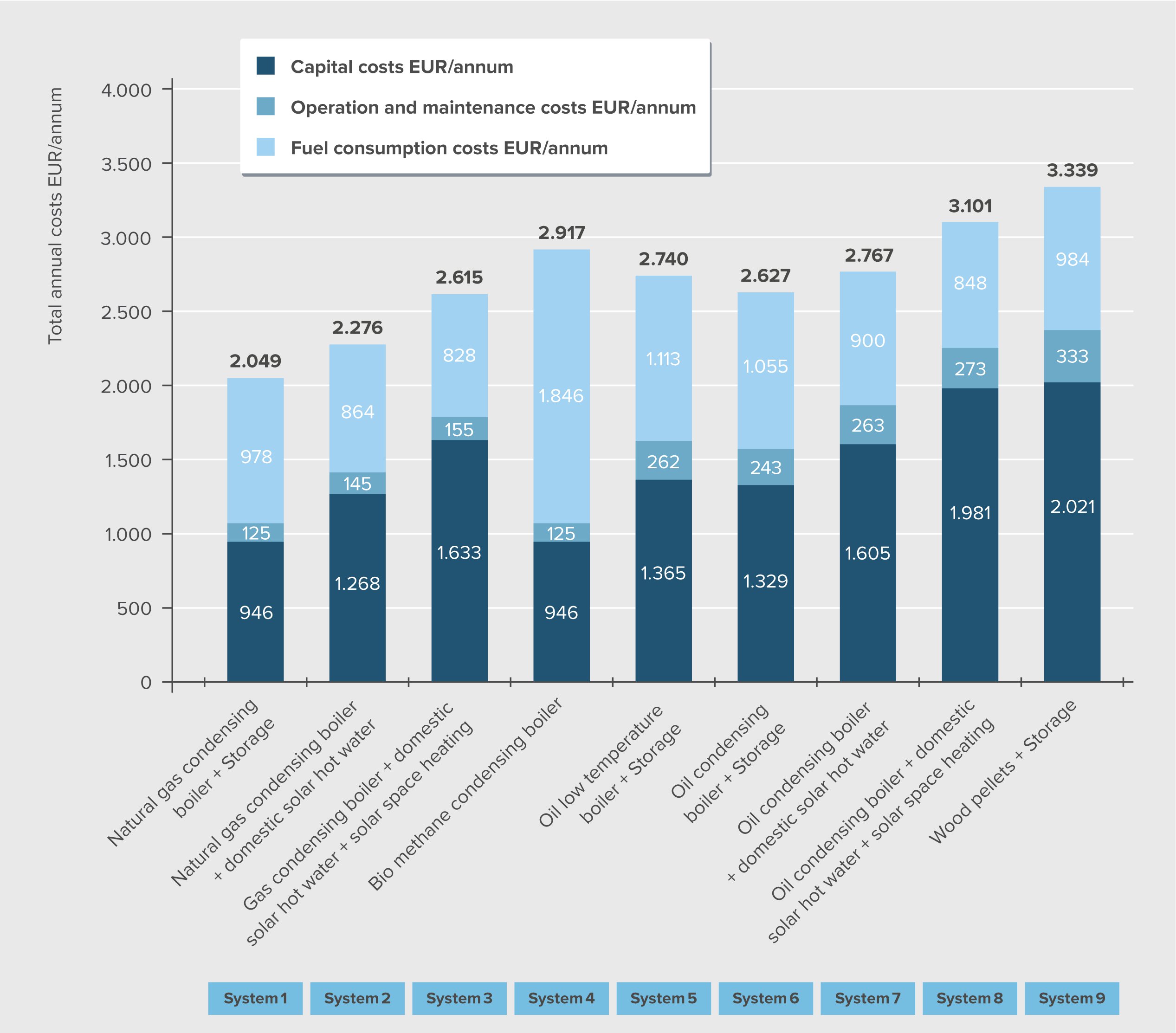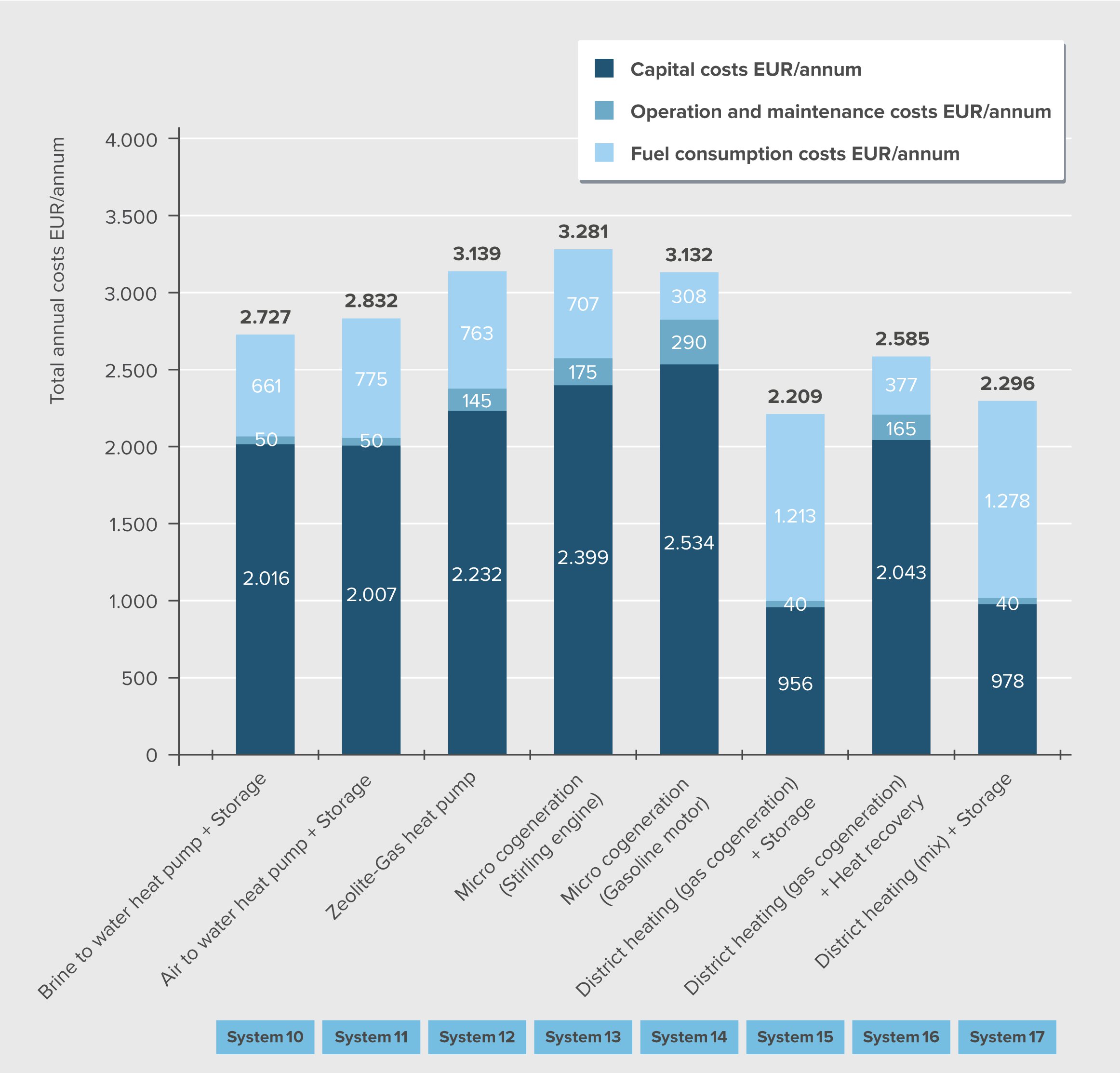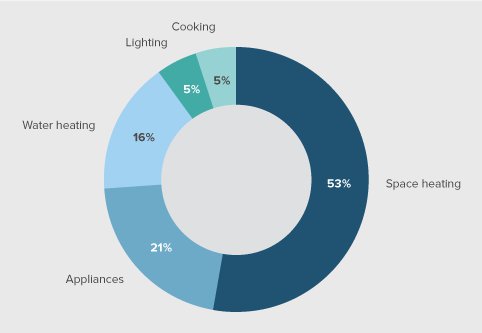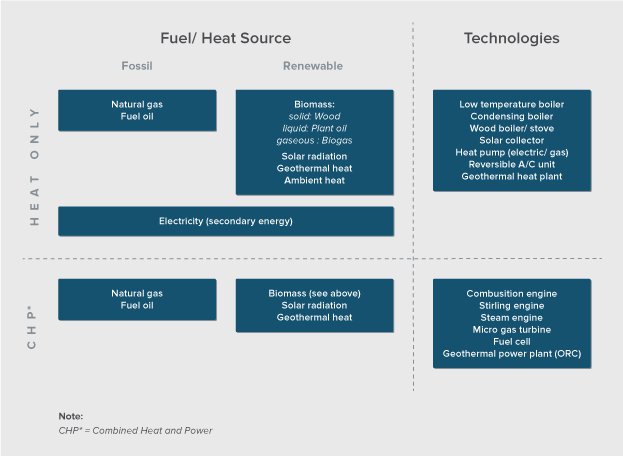Life cycle costs of a heating system depend on many constraints such as energy prices, taxes, subsidies, rate of interest and inflation, depreciation period, size, quality, energy efficiency, features, market maturity and comfort of the product, individual mounting situation, regional availability of resources, climate conditions, wage costs and so on. Principally they consist of three components:
- Annual capital costs
- Annual operational costs
- Annual consumption costs
The capital costs are determined by the investment costs, but also e.g. by the assumed rate of interest and depreciation period or by governmental taxes or support. Operational costs are expenditures for operation and maintenance (O&M), e.g. auxiliary materials, parts subject to wear and wages for staff and insurances. Consumption costs are determined by the energy consumption and thus they highly depend on the energy efficiency of the heating system and on the kind, availability and - in the end - prices of the used energy. As a rule heating technologies of high efficiency and / or with integration of renewable energy have higher upfront investment and hence higher capital costs compared to conventional technologies. On the other hand they save energy, i.e. consumption costs over life time and minimize the risk of rising energy prices (see table below).
Qualitative comparison of life cycle cost components for conventional and advanced heating technologies
| Technology |
Capital costs |
Operational costs |
Consumption costs |
| Low temperature boiler |
low |
low |
high |
| Condensing boiler |
low |
low |
medium |
| CHP (internal combustion) |
high |
medium to high |
low |
| CHP (stirling engine) |
high |
medium |
medium to low |
| CHP (fuel cell) |
very high |
medium |
very low |
| Solar thermal |
high |
low |
very low |
| Heat pump (air source) |
medium |
low |
medium |
| Heat pump (ground source) |
high |
low |
low |
| Pellet boiler |
high |
low to medium |
low |
The following tables give an exemplary overview of specific investment costs of some advanced heating technologies with high-energy efficiency performance (CHP) or with the integration of renewable energy (solar heating systems, heat pumps) in USD2007/kWth for OECD countries. Cardinally smaller systems (e.g. suitable for single family homes) are specifically more expensive than bigger systems (e.g. for multi-family-dwellings). That’s why it might be more reasonable to relate specific investment costs for heating systems not to the installed capacity (in kWth) but to the heated floor area (see for example the cost curves of diverse heating technologies in (BMVBS 2012) for the energetic renovation of residential buildings).
Cost characteristics of small- and large-scale CHP technologies in USD2007/kWth
| USD2007/kWel |
Large scale |
Small scale |
| Reciprocating engines |
1,000 – 1,600 |
1,500 – 12,000 |
| Gas and micro-turbines |
1,050 – 2,000 |
2,000 – 2,700 |
| Fuel cells |
5,000 – 11,000 |
8,000 – 28,000 |
IEA, 2011; P. 15
Cost characteristics of heat pumps for heating and cooling in single-family dwellings in USD2007/kWth
| USD2007/kWth |
North America |
China + India |
OECD Pacific |
OECD Europe |
| air-to-air |
360 – 625 |
180 – 225 |
400 – 536 |
558 – 1,430 |
| ASHP |
ASHP |
ASHP |
ASHP |
ASHP |
| (Air Source Heat Pump) |
475 – 650 |
300 – 400 |
560 – 1,333 |
607 – 3187 |
IEA, 2011; P. 17
Overview of solar heating system costs in USD2007/kWth in OECD countries
| Costs inUSD2007/kWth |
Europe |
Europe |
North America |
North America |
Pacific |
Pacific |
| - |
new build |
retrofit |
new build |
retrofit |
new build |
retrofit |
| Single-family dwellings |
1,140 – 1,340 |
1,530 – 1,730 |
1,200 – 2,100 |
1,530 – 2,100 |
1,100 – 2,140 |
1,300 - 2,200 |
| Multi-family |
950 – 1,050 |
1,140 – 1,340 |
950 – 1,050 |
1,140 – 1,340 |
1,100 – 1,850 |
1,850 – 2,050 |
IEA, 2011; P. 12; Typical sizes for solar water heater: 2.1 to 4.2 kWth (SFH) / 34 kWth (MFH), typical sizes for solar combi systems: 7 to 10.5 kWth (SFH) / 70 to 130 kWth (MFH)
Both for the renewable energy using technologies Solar Thermal and Heat Pump as for the new CHP technologies Fuel Cell and Micro-Turbines further reduction in investment costs are expected for the future as show in the table below.
Cost goals (installed cost in USD2007/kWth) for heating technologies in 2030 and 2050
| USD2007/kWth |
2030 |
2050 |
| Active solar thermal |
-50% to -75% |
-50% to -75% |
| Heat pumps (Space / water heating) |
-20% to -30% |
-30% to -40% |
| CHP: Fuel cells |
-40% to -55% |
-60% to -75% |
| Micro-turbines |
-20% to -30% |
-30% to -50% |
IEA, 2011; P. 25
Two examples for life a cycle cost comparison of heating systems
As described above numerous factors influence the result of a life cycle costs calculation. Therefore for every application in practice an individual calculation tailored to the local conditions is essential. In the following, two exemplary calculations are presented – one without and the other with the assumption of energy price increases over lifetime. Due to the varying assumptions the results of the both cost calculations are very different: In the first example with constant energy prices systems with low invest / capital costs are best. In the second example with increasing energy prices of 3 to 6 % per year the capital-intensive renewable and energy-efficient systems score better. Both examples are from the central European region (Germany with HDD18 of about 3155). The compilations in the following figure show life cycle costs for different conventional and advanced heating systems. The calculation has been done by ASUE, a German working group for the economical use of gas technologies, and bases on the following assumptions:
- New single family building with a useful area* of AN = 150 m2
- Specific annual heating demand for space heating of 50 kWh/m2 (7500 kWh per year)
- Specific annual heating demand for domestic hot water (DHW) of 12.5 kWh/m2 (1875 kWh per year)
- Rate of interest of 5 %
- Calculation with annuity method, annuity over the specific life time of the components accord-ing to VDI 2067
- Capital costs: expenses for investment and installation, less incentives of up to 2,500 € (depending on technology)
- Operational costs: expenses for maintenance, cleaning and insurance
- Consumption costs: expenses for energy and auxiliary energy, no energy price increases
- All quoted costs including VAT of 19 %
* The useful area AN is a fictive value according to the German Energy Saving Ordinance EnEV. It is calculated by the heated building volume Ve factored by 0.32. As a rule the real living space of the building is smaller, in the case of the considered building of AN = 150 m2 the living space amounts only for 111 m2.
Comparison of total annual costs for different heating systems (boiler systems with and without solar assistance) according to ASUE 2011

Source: Own compilation according to ASUE (2011b)
Comparison of total annual costs for different heating systems (heat pumps, CHP, mechanical ventilation with heat recovery) according to ASUE 2011

Source: Own compilation according to ASUE (2011b)
Assumptions for energy prices for the comparison of total annual costs for different heating systems according to ASUE (2011b)
| All prices including VAT of 19 %, no energy price increases over next 20 years |
Base price €/a |
Working price |
Heating value |
| Natural gas |
165 |
0.058 €/kWh |
- |
| Bio methane |
165 |
0.128 €/kWh |
- |
| Liquid gas |
240 |
0.597 €/l |
6.53 kWh/l |
| Fuel oil - Low sulphur |
- |
0.809 €/l |
10.081 kWh/l |
| Fuel oil - Standard |
- |
0.808 €/l |
10.081 kWh/l |
| Local / block heating |
350 |
0.068 €/kWh |
- |
| District heating |
500 |
0.060 €/kWh |
- |
| Pellets |
- |
0.225 €/kg |
4.9 kWh/kg |
| Electricity - Standard tariff |
- |
0.214 €/kWh |
- |
| Electricity - HP-tariff |
80 |
0.120 €/kWh |
- |
ASUE, 2011b; P. 23; Note: For own calculations see also the online-tool for heating system comparison of ASUE under: http://asue.de/service/kostenvergleich-heizung/index.html
Cost comparison of energiesparen-im-haushalt.de (energy saving in households) 2013
The calculation is made by energiesparen-im-haushalt.de, an independent Internet portal for the net-working of homeowner, manufacturer and energy consultants. It bases on the following assumptions:
- Investment costs for heating systems in new buildings
- Without consideration of costs for chimney, underfloor heating or other radiant panel heating
- Energy prices / yearly price increase: electricity: 26 ct/kWh / 5 %; pellet: 285 €/t / 3 %; Natural gas: 6.7 ct/kWh (+ 12 €/Month) / 6 %; Fuel oil: 0.92 €/l / 6 %
- Rate of interest: 4 %
Exemplary cost comparison of different heating systems: acquisition costs, annual costs and accumulated costs within 20 years in EUR (state: March 2013)
| Type of heating system |
Geothermal heat pump |
Wood pellets |
Gas condensing + solar |
Gas condensing |
Oil condensing |
| Investment and capital costs |
. |
. |
. |
. |
. |
| Heat generator |
9,000 |
9,000 |
3,000 |
3,000 |
4,000 |
| Installation |
1,500 |
1,500 |
2,000 |
1,000 |
1,000 |
| Geothermal probe, storage, collectors, silo / tank |
4,000 |
1,500 |
6,000 |
1,500 |
2,000 |
| Total investment costs |
14,500 € |
12,000 € |
11,000 € |
5,500 € |
7,000 € |
| Annual capital costs |
1,067 €/a |
883 €/a |
809 €/a |
405 €/a |
515 €/a |
| Consumption and operational costs (first year) |
. |
. |
. |
. |
. |
| Pellet / Gas / Oil |
- |
599 €/a
(2.1 t) |
499 €/a
(5,300 kWh) |
807 €/a
(9,900 kWh) |
948 €/a
(990 l) |
| Electricity |
728 €/a
(2.800 kWh) |
156 €/a
(600 kWh) |
130 €/a
(500 kWh) |
104 €/a
(400 kWh) |
104 €/a
(400 kWh) |
| Total consumption costs |
728 €/a |
755 €/a |
629 €/a |
911 €/a |
1,052 €/a |
| Maintenance costs |
100 €/a |
250 €/a |
250 €/a |
170 €/a |
300 €/a |
| Consumption and operational costs (21th year) |
. |
. |
. |
. |
. |
| Pellet / Gas / Oil |
- |
1,081 €/a
(2.1 t) |
1,601 €/a
(5,300 kWh) |
2,589 €/a
(9,900 kWh) |
3,039€/a
(990 l) |
| Electricity |
1,932 €/a |
414 €/a |
345 €/a |
276 €/a |
276 €/a |
| Total consumption costs |
1,932 €/a |
1,495 €/a |
1,946 €/a |
2,865 €/a |
3,315 €/a |
| Maintenance costs |
148 €/a |
371 €/a |
371 €/a |
253 €/a |
446 €/a |
| Total life cycle costs (over 20 years) |
. |
. |
. |
. |
. |
| Cumulated costs within 20 years (€) |
47,840 € |
44,970 € |
44,920 € |
45,360 € |
55,890 € |
Verbraucherzentrale.nrw, 2016

